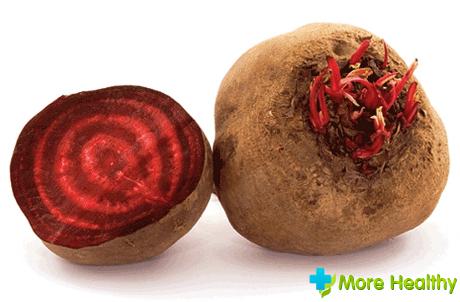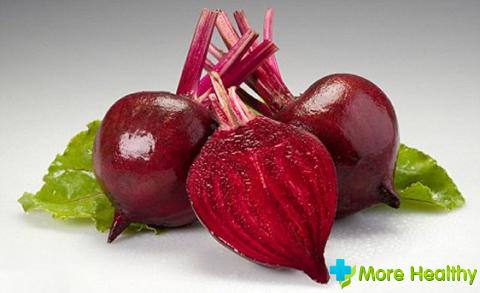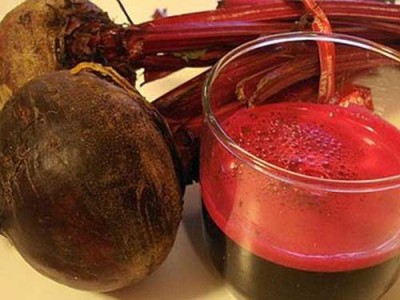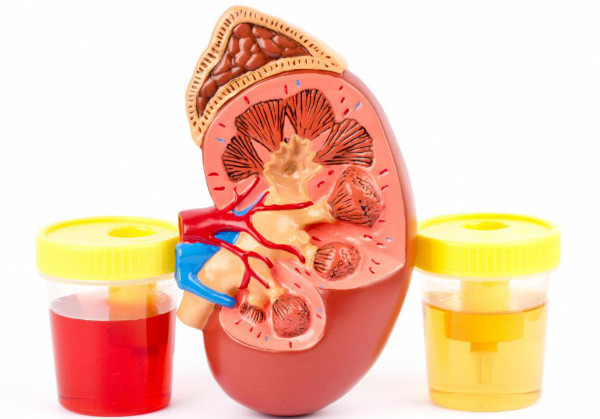Urine is one of the main organs of human life, and its color can say a lot. Changes in the shade or color of urine may be the first sign of a serious illness. Red urine after beets, is this normal?
Changing the color of urine can make a person feel anxious. However, there is no need to worry if you have recently consumed beets. Why does urine change color? Normal color urine - yellow. But, in the presence of kidney diseases, it can change its color. Red urine indicates a serious disorder and change in the human body. It is not always so. To accurately determine the cause of the red tint, it is necessary to evaluate the quality of urine.
The main criteria by which the quality of urine can be determined:
- First of all - quantity. Daily norm fluid discharge is 1.5 liters. Excessive or insufficient urine volume can become a significant problem. The case when the patient does not remove fluid from the body at all is quite serious, and may also be a sign of the presence of various urinary diseases excretory system. In this case, you need to consult a urologist.
- Cloudiness in the urine is a sign of exposure to infections and pathogens. The liquid in its normal state should be completely transparent. Cloudiness may also occur with dehydration. In this situation, it is necessary to restore the water-salt balance. To do this, your doctor may prescribe the use of sodium bicarbonate and sodium chloride. It is also necessary to maintain a drinking regime.
- The presence of lumps may occur due to the excessive presence of glucose in the human body. May occur due to renal diabetes.
- Smell is also an important indicator. The natural smell of urine is a little specific, however, it is not harsh and extremely unpleasant. In the presence of diseases such as pyelonephritis, hydronephrosis, cystitis, the patient’s urine acquires the smell of ammonia.
- And one of the main factors is the color of the liquid. The normal color ranges from light yellow to straw. A change in color may indicate a serious pathology or disorder that requires treatment.
Red color of urine after beets
However, urine color may change to red due to recent consumption of beets. Specifically, the color change is affected not by the vegetable itself, but by its juice, which is rich in a substance such as betanin. It is thanks to betanin that the vegetable acquires its bright shade. Freshly squeezed beet juice contains many beneficial substances, which is why it is often used for health benefits. In addition to betanin, beets are rich in vitamin C, zinc and selenium. Data minerals Help the body form protective cells. Betanin, turning the liquid red, can cause anxiety in the patient. For many, red urine is a sign of serious problems.
Is it normal to have red urine after beets? Of course, after eating beets, pink and red urine may occur. The color of the liquid can vary from pink to dark red. Don't be alarmed if your urine suddenly turns red. This is due to the effects of the betanin pigment contained in the vegetable. This pigment is coloring. It is thanks to him that urine from beets becomes red, and feces can also be red.

There are several opinions about the appearance of red color in urine:
- Some argue that reddish urine after eating beets may be due to dysbiosis. The coloring pigment affects only a person with affected microflora, when it does not manifest itself in any way in a healthy person.
- Another opinion suggests that pink urine after beets appears when kidney function is impaired.
In most patients who have undergone diagnosis and treatment, the problem of urine staining disappears. That is why, for preventive purposes, you should consult a doctor who will prescribe the appropriate medications. The doctor can also prescribe diagnostics that can identify pathologies of the kidneys, ureters, and bladder.
A course of treatment
If the color of urine changes, you should not self-medicate. You should consult a doctor who will prescribe the appropriate diagnosis, and then treatment. If after eating beets the urine turns pink or red, no special treatment is required. However, beet-colored urine can be a sign of various inflammatory and infectious diseases. First of all, the doctor will prescribe a diagnosis for the patient.
Diagnostic methods:
- A general urine test is essential. It is one of the most informative diagnostic methods, helping to detect inflammatory processes and diseases.
- A blood test will be required to determine red blood cells and hemoglobin levels. If a low hemoglobin level is detected, the patient will be prescribed medications.
- In some cases, the doctor may provide a referral for an ultrasound of the kidneys and abdominal cavity. This is done in order to identify diseases of the urinary system.
It is highly not recommended to self-medicate, since red urine is not always a consequence of the effects of diseases, and the patient may harm himself with medications. It is necessary to carefully monitor the color and consistency of the discharge, since the slightest changes in the color, smell or consistency of urine can be a sign of the impact of the disease. A timely visit to a doctor will help to avoid the development of many complications, as well as begin treatment at an early stage of the disease.
You can also perform a urine test at home. This method will help determine why the urine is colored: due to the presence of red blood cells or due to the effects of betanin.
To conduct the experiment, you will need vinegar, soda and collected urine. You need to add a little soda to the urine, then add a drop of vinegar. If the color of the liquid disappeared after adding soda, but reappeared after adding vinegar, then you should not worry. The coloring of urine was due to exposure to pigment. However, in any case, it is extremely necessary to visit your doctor, because the test performed does not have high level reliability.
There are also traditional methods prevention. They include frequent visits to the bathhouse and sauna. It is necessary to use kidney collection, various teas with the addition of linden, honey and raspberries, you can also use a white root vegetable similar to radish. It is also necessary to avoid hypothermia, as this has a detrimental effect on kidney health. However, if your urine does not change color, you should visit a doctor.
Besides folk remedies prevention, you should take medications prescribed by your doctor. Drugs prescribed for antibacterial therapy:
- Urolesan is a medication designed to remove kidney stones and relieve pain. The drug is also anti-inflammatory.
- Furagin, like urolesan, has anti-inflammatory and antibacterial effects. Helps the name system cope with the disease.
The urine color may change to red due to the effects of betanin. Betanin is a pigment found in beets. However, to be sure of the exact cause of red urine, you need to visit your doctor, who will prescribe the appropriate course of treatment and diagnosis.
The state of urine can often be used to judge the general health of a person. That is why, during various preventive examinations, doctors prescribe to patients general analysis urine, and if any disease is suspected, more specific tests are prescribed, such as, for example, a urine test for sugar or bacteriological urine culture.
Physical properties of urine
According to its physical state, urine is characterized by quantity, transparency, density, color and odor:
- Quantity
The daily urine output of a healthy person averages 1.5 liters. A significant decrease or increase in daily diuresis causes disturbances in the normal functioning of the body. The absence of urine, or its amount not more than 50 ml per day, poses a serious threat, as it is a symptom of a number of diseases that require immediate treatment.
- Transparency
Distinctive characteristic of urine healthy person is its transparency. Insufficient fluid intake causes temporary cloudiness of the urine and is not a sign of any disease. As a rule, after taking the amount of fluid required by the body, urine becomes clear. The cloudy and foamy appearance of urine is caused by proteins present in it. crystalline substances and pus, this is a symptom of various diseases.
- Density
An increase in the density of urine is caused by the presence in it, as well as substances that enter the urine due to intravenous infusion. Renal and acute renal tubular damage are the cause of decreased urine density.
The normal urine color of a healthy person ranges from clear white to straw yellow. Urine tends to change color depending on the time of day, the amount of fluid consumed, and the composition of food. For example, morning urine is always darker than urine during the day, which is always lighter.
- Smell
Normally, urine has a specific, mild odor. Various diseases can change its smell. For example, with diabetes, the urine smells like rotting apples.
Causes of urine color change

The color of urine can be affected by medications used for various diseases, the presence of diseases and products containing dyes:
- Brown-red color. Caused by blood in the urine due to glomerulonephritis, kidney stones, and tumors.
- Pink and reddish color. The reason for this color may be food with red pigments - blueberries, blackberries, red peppers, beets, baked goods with rhubarb.
- Yellow-green color. It is observed with a significant content of pus in the urine and while taking anti-inflammatory drugs and antidepressants. The cause of green urine may be an increase in bilirubin, which is a signal of liver and pancreas disease. Eating asparagus and spinach gives the greenish color to urine.
- White color. Associated with a large amount of phosphates and calcium phosphate salts in the urine, which indicates a disturbance in calcium-phosphorus metabolism. If there is pus in the urine, its color may take on a grayish tint.
- Bright orange color. It happens when taking blood thinning medications, as well as when using large quantity beta-carotene contained in carrots.
Red urine after eating beets
Many people get scared when they see red urine after eating beets. But is there really any reason to worry? There is no clear answer to this question, and even experts have differing opinions on this issue.

Some of them believe that red urine after eating beets is quite normal. Others say that in a healthy person, the urine after beets does not change color, and the red color indicates the presence of dysbacteriosis. There is also an opinion that the red color of urine after taking beets means that a person has kidney problems. Another theory states that coloring of urine after eating beets is one of the signs of iron deficiency anemia.
How to determine the cause of red urine
To remove all doubts about why the urine turned red (from the presence of blood in it or from beets) can be simple and very quick way. A small amount of baking soda should be poured into the urine, and then table vinegar should be added. If the color from the baking soda disappears and reappears after adding vinegar, then the red color of the urine is caused by eating beets, not blood.
You should also pay attention to the fact that urine that has turned red from taking beets is transparent, but due to the presence of blood it has a cloudy appearance.
In order to determine whether there really are diseases such as dysbiosis, iron deficiency anemia or kidney problems, the symptoms of which may be red urine after taking beets, you should consult a doctor. The necessary tests and diagnostics will help determine the cause of the change in urine color.

The overwhelming number of people assume that red urine after beets is a typical situation after taking the product, while some are of the opinion that coloring of the discharge should not occur, and that the change that has occurred is associated with a disruption in the functioning of the body. So, can urine be red if beets have been eaten, and what factors influence the color transformation? This information will help you figure it out.
Characteristics and properties of urine
To assess the quality of urine at home, each person should know the basic characteristics of this biomaterial for a healthy body. The quality of urine excreted can be assessed by the following characteristics:
- 1 Quantity. The optimal volume of urine excreted per day should be about 1.5 liters. If daily discharge is significantly less or more than normal, this indicates disturbances in the functioning of the body. If the amount of urine excreted during the day is less than 50 ml or its complete absence, we can talk about the presence of serious illnesses, treatment of which must be started as quickly as possible.
- 2 Transparency. A normally functioning body should produce clear urine. The presence of slight turbidity may indicate an insufficient amount of fluid consumed. Typically, after recovery water balance In the body, urine becomes clear again. If the discharge is very cloudy and foaming, you should consult a doctor, as this condition may indicate the development of a disease.
- 3 Density. Most often, thickening of urinary secretions occurs due to glucose and other substances entering the urine through intravenous injections. The presence of renal diabetes or acute damage to the renal tubules is responsible for the decrease in density.
- 4 Smell. The smell of urine is quite specific, but it is not pungent. A change in this characteristic most often occurs due to the development of the disease. The ammonia smell of discharge may indicate infectious diseases of the urinary system, such as pyelonephritis, cystitis, urethritis.
- 5 Color. A natural healthy body should be pale yellow to straw in color. Also, the color of the discharge may change during the day due to the consumption of liquids and various foods.


If the urine turns red after eating beets, can this be considered a natural process or should it be considered a symptom? possible pathology?
Reasons for color change
It is known that the change in color of discharge is affected not by the beets themselves, but by their juice. Most often, beet juice is taken as a health remedy that has a beneficial effect on the functionality of the body.

But there is still no consensus whether the urine from beets can be red due to the pigments in the vegetable, or whether the reason for this phenomenon lies elsewhere. Today, there are several main opinions that try to explain the change in color due to consumption of the vegetable:
- 1 Some argue that red urine after eating beets clearly indicates that there are problems in the body internal organs, namely the kidneys. Therefore, if a change in color is detected, you should consult a doctor as soon as possible to prescribe the correct treatment.
- 2 Among opponents, it is generally accepted that urine may be red from beets due to dysbacteriosis. Eating a vegetable when the balance of the microflora changes makes itself felt in the form of redness of the discharge, while in a healthy person the color of the urine will not change.
- 3 It is also believed that the red color of urine after eating indicates that a person has iron deficiency anemia. With a reduced number of red blood cells and/or hemoglobin levels, consumption of beets can lead to significant coloration of urine, which will indicate the presence of pathology.
- 4 Another side refers to the fact that no doctor will make a correct diagnosis without preliminary tests and diagnostics. Red urine after eating beets may indicate kidney problems, but this condition is not necessary for every person. Some people may experience changes in the color of their urine without having a medical condition.
While there are various theories explaining the reason why the color of urine changes after eating beets, many experts claim that often even people who do not complain, who have undergone a course of medical therapy, note a normalization of the color of urine even after eating the vegetable.
Therefore, if you observe staining of urine, you should consult a doctor about diagnosing infectious kidney diseases.
Principles of treatment
If, after eating beets while visiting the restroom, you notice that your urine has turned red, you should not self-medicate or take any medications without the prior approval of your doctor.

First of all, the specialist prescribes a set of diagnostic measures aimed at identifying the reasons why the urine might be colored, and, depending on the disease, prescribes competent treatment. In this case it will be necessary:
- 1 . It is necessary to identify inflammatory or infectious disease in internal organs and other pathologies.
- 2 Take general and biochemical blood tests to determine the level of hemoglobin and the number of red blood cells per unit of blood.
- 3 Perform an ultrasound examination of the abdominal organs if you suspect diseases of the kidneys and/or urinary system.
- 4 Undergo other laboratory and diagnostic tests.
If, based on the results of the diagnostics, it is revealed that after eating beets, the urine is red due to a lack of hemoglobin, i.e. Iron deficiency anemia has been diagnosed, in which case the doctor recommends taking iron supplements, which include: Actiferrin, Hemohelper, Ferlatum, Fenyuls.
Most often, to treat the cause of changes in the color of urine in the form of infectious kidney diseases, complex therapy is used, consisting of a course of antibacterial and anti-inflammatory drugs. The patient is prescribed the following medications:
- 1 Urolesan. The product is intended for the treatment of infectious diseases of the kidneys and the removal of stones from them, while it has an anti-inflammatory and analgesic effect. Most often prescribed for the treatment of pyelonephritis, cystitis, and urolithiasis. Contains mainly natural ingredients: essential oils and extracts medicinal herbs.
- 2 Phytolysin. The action of the drug is based on its bactericidal, diuretic and analgesic properties. The product is available in the form of a paste for oral use, which contains the following components: natural origin. Diseases for which the use of the drug is recommended include pyelonephritis in acute and chronic forms, urolithiasis. In this case, a contraindication for taking this drug is the presence of glomerulonephritis, nephrosis and renal failure in the patient.
- 3 Furagin. In addition to its antimicrobial and antibacterial effects, the drug is able to activate immune system, helping the body cope with the infection on its own. The drug is recommended for the treatment of acute and chronic diseases of the urinary system, but is strictly contraindicated for infectious diseases of the renal parenchyma.
It must be remembered that if the urine changes its color to red after consuming beets, this is not always a consequence of an infectious disease in the kidneys. Therefore, before using any of the above drugs, it is necessary to consult with a specialist about the need to prescribe treatment, having first tested necessary tests and undergoing additional diagnostics.
Another trivial reason why, after eating beets, the urine could turn red is abuse of physical activity.
Moreover, after evenly distributing effort on the exercises, the discharge after beets acquires its natural shade.
Traditional medicine recipes
As mentioned above, the red color of urine after eating beets does not always signal problems in the functioning of internal organs, in particular the kidneys. But to prevent color changes after eating a vegetable, traditional therapy suggests following some recommendations:
- 1 Visit baths or saunas as often and regularly as possible, but only if this is not contraindicated for other existing diseases. At the same time, steam procedures using essential oils from coniferous species trees that have anti-inflammatory and antibacterial effects. After warming up the body, manual massage in the back and buttocks is very useful.
- 2 Avoid hypothermia. Therefore, you should avoid dousing cold water, swimming in pools and rubbing with snow.
- 3 It is recommended to regularly drink teas with the addition of raspberry, linden, honey or sage, which have a wonderful diaphoretic effect.

Following the rules traditional medicine, you should not neglect traditional therapy, especially if you have been worried for a long time after eating beets.
Diagnostic measures
By regularly monitoring your urine (its color, consistency, smell and other characteristics), you can notice the occurrence of various diseases at an early stage and begin treatment. That is why you should not neglect such a simple and accessible method of diagnosing the condition of the body.
In addition to visual tracking, there is one method that allows you to examine urine, or rather, determine the approximate cause of the change in color and understand whether it was colored due to the presence of blood or whether it was due to the influence of red pigments from consumed beets.
To conduct your own research, you will need baking soda, vinegar, and a collected sample of colored urine. To begin, add a small amount to the discharge sample. baking soda, after which a drop is added to it table vinegar. If after adding soda the unnatural color of urine disappeared, and after adding vinegar essence it appeared again, then you don’t have to worry - the red color of the urine was not due to blood getting into it, but changed under the influence of the product eaten.
Unfortunately, such a test does not have great reliability of the results obtained, therefore, if some problems arise in the functioning of internal organs and the urine turns red after eating beets, it is strongly recommended to consult a doctor.
In addition to the reasons for the coloring of urine, some are interested in how many days the unnatural color of the discharge can remain if beetroot juice has been consumed. Experts answer that this requires 1-2 days. If after this time a red tint still predominates in the color of the urine, then most likely the cause of this phenomenon lies not in food, but in a more serious abnormality.
- change in urine color
- various secretions in the urine
- acrid smell of urine
Can there be red urine after beets? The urinary system and its functioning directly depend on what a person eats. The quantity, color and quality of urine may vary depending on food and daily diet. After eating beets, your urine may be red or similar in color to the food. Such indicators are considered the norm in most cases, but there may be exceptions that are not related to the presence of vegetables in the diet.
Can urine have a characteristic color? Of course yes, because the kidneys process all products, which changes the structure of urine.
Vegetables and fruits should certainly be present in the daily diet; they have many beneficial qualities and are simply irreplaceable for a person’s well-being. Beetroot is a complex of vitamins, microelements, it has a mass useful properties. It is actively used in the diet of children and athletes, in preparing various dishes and making juice. This vegetable has antioxidant properties, improves performance, but can color urine.
The reasons for this phenomenon are quite understandable; they can be highlighted as follows:Why does urine turn red after eating beets? This is normal and may be a natural metabolic process in the kidneys. The composition of urine may change, because it consists of the remains of processed food.
- a large amount of betanin;
- a large amount of product with a characteristic color;
- taking medications;
- genetic predisposition;
- environmental factor.
In addition to the main points, the reasons may be hidden in quite familiar actions: improper storage, canned products, the type of vegetable itself, of course, can affect the color of urine, staining it. With increased acidity, urine turns red much more often. This phenomenon can last about two days, and nothing can affect this indicator.
Why do beets turn my urine red? The reasons for coloring urine can be different and most of them are associated with heredity, as well as the selected vegetable.
Symptoms of changes
After beets, red urine is considered normal if this indicator does not hide any diseases.
If additional symptoms are present, the person must seek help from a specialist and also undergo all the necessary laboratory tests.
The main signs that began to cause concern:- Abdominal pain, bloating and discomfort, which may intensify.
- Loose stools and frequent urge to go to the toilet are also deviations after eating a vegetable.
- Urine is colored bright color, may have various impurities.
Such indicators cannot be the norm and require medical diagnosis. The structural composition of urine is an important diagnostic marker that indicates the general condition of the whole organism. When diagnosing diseases, laboratory urine analysis is a mandatory procedure. The real reasons Deviations can only be explained by specialists after the examination. Unpleasant signs may appear, after which the urine changes color. This condition is certainly considered a manifestation of the disease and requires correction by a specialist.
A coloring pigment can change the color of urine, but red urine is not always normal. It is worth carefully studying additional symptoms.
Red or pink urine after beets may be normal, but sometimes this composition indicates an imbalance in the body. When urine is stained, other signs may appear that indicate a lack of nutrients in the body.
Women and men experience similar symptoms, namely:
- constant fatigue;
- pale skin;
- inability to concentrate.
Such indicators occur due to a lack of iron, and also indicate various diseases, even if the urine from beets changes color.
But if the beets were not eaten, and the urine has a characteristic shade, then this indicates the development of pathology, namely:- changes in the genitourinary system;
- infectious diseases;
- intoxication;
- kidney diseases.
In any case, why urine changes color, it is better to consult a specialist. But don't rule it out healthy vegetable from the diet. The coloring of urine is a consequence of beet enzymes, which are processed in the human excretory system.
Urine (urine) is a product of the body's excretory system. In humans, urine production occurs through the kidneys. All substances entering through the alimentary canal, and products of metabolism, breakdown and oxidation, which are formed after the work of internal organs, enter the parenchymal renal filter and are excreted through the urinary canal. In this regard, urine contains a large amount of tissue and chemical elements and suspensions that are in a certain environment and volume.
The normal color of urine is light yellow, but when taking certain foods, medications, or when pathological processes occur, the urine may turn a different color. Also, the color of urine depends on the concentration of substances in it; the more substances there are, the darker it will look. If the volume of urine increases, its color becomes light.
For example, in a newborn baby, urine is similar in color to water because metabolic processes in the baby’s body they are just beginning to gain activity in functioning digestive system. At the age of one year, the urine may acquire a yellow tint, since, in addition to breast milk, additional nutrition is introduced.
In both children and adults, urine can be colored different colors: red, white, greenish, orange, pink and dark gray. Why does this happen, and how can the change in urine color be explained?
Natural dyes
 If you eat beets, their juice or vinaigrette, many people notice a red color to their urine. This phenomenon should not frighten a person if it is observed precisely after eating beets and does not bring any discomfort. The fact is that beets contain a natural coloring glycoside called anthocyanin. Anthocyanins color plants depending on the intracellular environment. Some fruits, vegetables, berries and ornamental crops with an acidic environment they are red, with an alkaline environment - yellow and with neutral – purple.
If you eat beets, their juice or vinaigrette, many people notice a red color to their urine. This phenomenon should not frighten a person if it is observed precisely after eating beets and does not bring any discomfort. The fact is that beets contain a natural coloring glycoside called anthocyanin. Anthocyanins color plants depending on the intracellular environment. Some fruits, vegetables, berries and ornamental crops with an acidic environment they are red, with an alkaline environment - yellow and with neutral – purple.
Human urine also has its own environment: semi-acidic, acidic, neutral and alkaline. It depends on food, drinks and other internal processes in the body. The normal urine environment is considered an indicator of human health. If the acid in the urine is elevated for several days, this may be accompanied by a loss of strength and the appearance of bacterial flora. Some people do well with alkaline urine. It is she who does not change color when exposed to anthocyanins.
That’s why not everyone’s urine becomes colored after being saturated with beets, that is, pink and red color of urine can only be observed when such glycosides interact with an acidic environment. A similar reaction in changing the color of urine can be observed when eating carrots, blueberries, spinach, blue cabbage, etc.
Pathological processes and diseases
It should be noted that the cause of urine staining is not always food related. Let's look at this clinical example : A 55-year-old man came to see a doctor with a complaint of red urine that had been present for several days. At first, he was sure that such urine came out after eating beets, but when such urination became frequent, painful and not related to food, he wanted to be examined. When performing a urine test according to Nechiporenko, a large number of red blood cells were detected. After additional examination, the diagnosis was made: Prostate cancer.
 From this example, we can conclude that blood in the urine turns it pink or red. The normal content of red blood cells can be up to 1000 in one milliliter of urine. An increase in their level indicates diseases such as:
From this example, we can conclude that blood in the urine turns it pink or red. The normal content of red blood cells can be up to 1000 in one milliliter of urine. An increase in their level indicates diseases such as:
- Kidney failure;
- Kidney infarction;
- Cystitis;
- Stone formation in the urinary system;
- Hemolytic anemia;
- Glomerulonephritis;
- Injuries;
- Tumors of the reproductive and urinary system.
Pink, red, brown and brown colors are also observed when taking medications:
- Rifampicin (a drug that has a detrimental effect on Koch's bacillus for tuberculosis);
- Salol, phenyl salicylate (antiseptics);
- Aspirin (Acetylsalicylic acid);
- Phenolphthalein, amidopyrine (laxatives);
- Furadonin (antimicrobial nitrofuran);
- Metronidazole, trichopolum (drugs against anaerobic infections and protozoan pathogens).
Along with the strange color of urine, you may also feel bad smell. The presence of acetone spirit indicates pancreatic dysfunction ( diabetes). Metabolic disorders that occur during fasting and long-term dieting can cause ammonia or fishy odor in urine. The presence of putrefactive microorganisms in the genitourinary system is indicated by the foul odor of urine. Often, after taking a large amount alcoholic drinks, when urinating, there is a sharp and unpleasant smell of mash. Plastic, chemical, or sour smells may occur after eating certain foods and medications.
If the reason for the change in the color and odor of urine is not the result of natural or synthetic substances entering the body, you must contact a physician, urologist or gynecologist to undergo diagnostic measures and rule out possible illness. If during treatment you use decoctions, infusions of medicinal herbs or other medications, then you need to study the instructions for their use and consult with your doctor about possible adverse reactions in the form of urine of an unusual color and smell.

